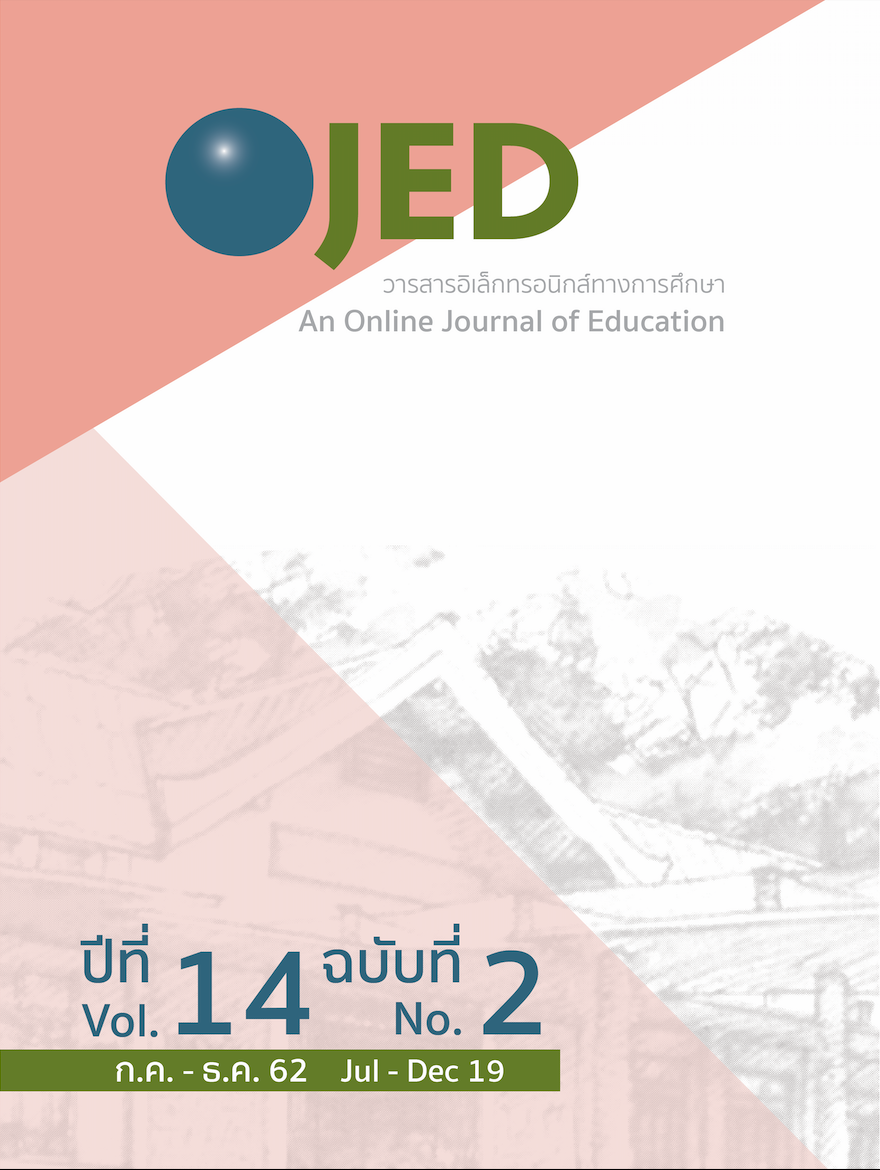แนวทางการพัฒนาภาวะผู้นำแบบกระจายความเป็นผู้นำของผู้บริหารโรงเรียน สังกัดสำนักงานเขตพื้นที่การศึกษาประถมศึกษา
DOI:
https://doi.org/10.14456/ojed.2019.53คำสำคัญ:
ผู้บริหารโรงเรียน, ภาวะผู้นำแบบกระจายความเป็นผู้นำบทคัดย่อ
การวิจัยครั้งนี้มีวัตถุประสงค์เพื่อศึกษาสภาพปัจจุบันสภาพที่พึงประสงค์และความต้องการจำเป็นในการพัฒนาภาวะผู้นำแบบกระจายความเป็นผู้นำของผู้บริหารโรงเรียน สังกัดสำนักงานเขตพื้นที่การศึกษาประถมศึกษา สุพรรณบุรี เขต1 ตัวอย่าง คือ ผู้บริหารและครูผู้สอน ในโรงเรียนประถมศึกษา จำนวน 78 โรงเรียน ๆ ละ 3 คน รวมทั้งสิ้น 234 คน เครื่องมือที่ใช้ในการวิจัย คือ แบบสอบถาม วิเคราะห์ข้อมูลด้วย ค่าความถี่ ค่าร้อยละ ค่าเฉลี่ยเลขคณิต และส่วนเบี่ยงเบนมาตรฐาน ค่าดัชนีความต้องการจำเป็น (PNImodified) ผลการวิจัยพบว่า1) สภาพปัจจุบันของภาวะผู้นำแบบกระจายความเป็นผู้นำของผู้บริหารโรงเรียน ในภาพรวมอยู่ในระดับมาก สภาพที่พึงประสงค์โดยรวมของภาวะผู้นำแบบกระจายความเป็นผู้นำของผู้บริหารโรงเรียน ในภาพรวมอยู่ในระดับมากที่สุด 2) ความต้องการจำเป็นในการพัฒนาภาวะผู้นำแบบกระจายอำนาจของผู้บริหารโรงเรียนสังกัดสำนักงานเขตพื้นที่การศึกษาประถมศึกษาสุพรรณบุรี เขต 1 ที่อยู่ในลำดับสูงที่สุด คือ ด้านวิสัยทัศน์ พันธกิจและเป้าหมายร่วม (PNImodified = 0.213) รองลงมาคือ ด้านกระบวนการตัดสินใจ (PNImodified = 0.207) ด้านการประสานงานและความร่วมมือ (PNImodified = 0.206) และด้านความรับผิดชอบและความตระหนักต่อหน้าที่ (PNImodified = 0.178) ตามลำดับ
เอกสารอ้างอิง
https://www.moe.go.th/moe/th/news/detail.php?NewsID=47677&Key=news_research
กระทรวงศึกษาธิการ. (2560) แผนพัฒนาการศึกษาของกระทรวงศึกษาธิการฉบับที่ 12 (พ.ศ.2560-2579)
สืบค้นจาก https://www.onec.go.th/index.php/page/view/Outstand/2532
ไพฑูรย์ สินลารัตน์. (2557). ทักษะแห่งศตวรรษที่ 21 ต้องก้าวให้พ้นกับดักของตะวันตก. กรุงเทพฯ:
มหาวิทยาลัยธุรกิจบัณฑิตย์
สถาบันวิจัยเพื่อการพัฒนาแห่งประเทศไทย. (2558). รายงานทีดีอาร์ไอ แนวทางการแก้ปัญหาโรงเรียน
ขนาดเล็ก. กรุงเทพฯ: ม.ป.ท.
ภาษาอังกฤษ
David, D. S., & Sheth, S. (2009). Mindful teaching and teaching mindfulness: A guide for
anyone who teaches anything. Somerville, MA: Wisdom.
DeMatthews, D. (2014). Principal and Teacher Collaboration: An Exploration of Distributed
Leadership in Professional Learning Communities. International Journal of Educational
Leadership and Management, Vol. 2(2).
Elmore, R. (2000). Building a new structure for school leadership. Washington, DC: The
Albert Shanker Institute.
Gronn, P. (2002). Distributed leadership as a unit of analysis. Leadership Quarterly.
Harris, A. (2014). Distributed Leadership Matters Perspectives,Practicalities,and
Potential. California : A SAGE Company.
Hallinger, P., & Heck, R. H. (2010). Collaborative leadership and school improvement:
Understanding the impact on school capacity and student learning. School Leadership
and Management.
Harris,A. & Muijs, D. (2004). Teacher leadership:Principles and practice. General Teaching
Council.
Humphreys, E. (2010). Distributed Leadership and Its Impact on Teaching and Learning.
Education Doctorate Thesis. Ireland: NUI Maynooth Education Department.
Leithwood, K. & Jantzi, D. (2006). “Linking leadership to student learning: the contribution of
leader efficacy”. Educational administration quarterly.
Southworth, G, 2004, Primary School Leadership in Context: Leading small, medium and
large-sized primary schools, London, Routledge Falme.
Spillane, J.P., Halverson, R. & Diamond, J.B. (2004) ‘Towards a theory of leadership practice:
a distributed perspective’, Journal of Curriculum Studies.
Spillane, J.P., (2006). Distributed Leadership United States of America: A Wiley Imprint.
Spillane, J. (2006). Distributed leadership. San Francisco, CA: Jossey-Bass
Spillane, J. & Diamond, J. (2007). Distributed leadership in practice. New York:
Teachers College Press.
ดาวน์โหลด
เผยแพร่แล้ว
รูปแบบการอ้างอิง
ฉบับ
ประเภทบทความ
สัญญาอนุญาต
ลิขสิทธิ์ (c) 2019 วารสารอิเล็กทรอนิกส์ทางการศึกษา

อนุญาตภายใต้เงื่อนไข Creative Commons Attribution-NonCommercial-NoDerivatives 4.0 International License.




